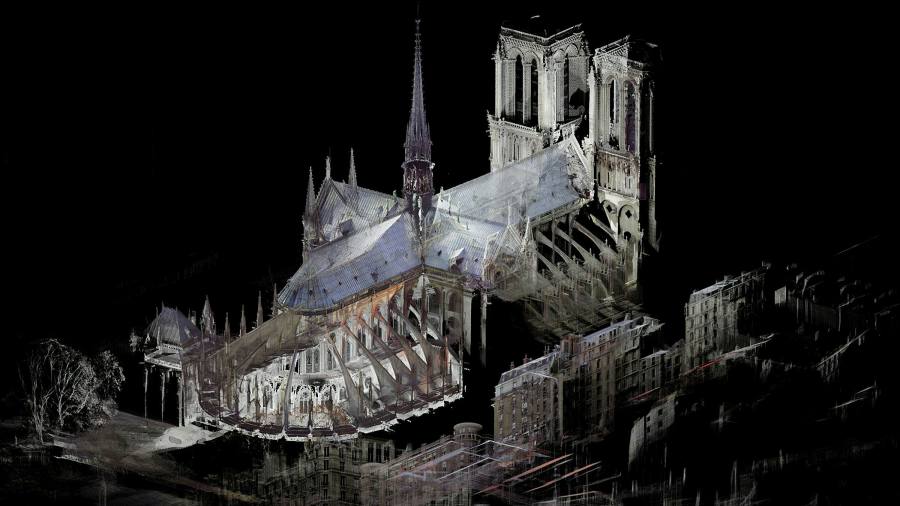[ad_1]
On April 15 2019, the apocalyptic images were broadcast live across the globe from Paris: whirlwinds of fire flashing through the upper tiers of Notre-Dame cathedral that transformed its spire into a blazing missile which crashed down through its ancient limestone vaults.
A barrage of Twitter posts sketched out a priest’s quest to save the site’s most sacred relic — the Crown of Thorns — as Parisian pompiers did battle with the flames through the night.Â
By dawn, a wider contingent of protectors had begun to form: a coalition of art historians and architects, computer scientists and digital designers stretching from London to Tokyo, New York and Marseille who aimed to rescue the great cathedral and give it a new life. They have joined forces to intermesh leading-edge virtual reality, 3D modelling and cloud computing technologies to create a “virtual twin†of the cathedral to power its real-world rebirth.
Robot-sentries outfitted with cameras now patrol the burnt-out shell of the structure, sending endless streams of images to update its virtual double. The simulated cathedral will reflect changes made in real time as the reconstruction progresses, says Livio De Luca, research director at France’s National Centre for Scientific Research. An architect with advanced degrees in computer science and engineering, De Luca first proposed this virtual-to-physical resurrection project during an emergency meeting of the French Senate: he now leads the digital contingent set up with France’s Ministry of Culture to spearhead the epic rescue mission.Â
Billion-pixel cloud images were combined with intricate panoramic photographs to create the most technologically advanced virtual clone ever unveiled for a World Heritage icon, he explains. As they strap on VR headsets, engineers and experts on medieval architecture can glide through the Matrix-like simulation as they remake the cathedral.
The imagery is incredibly precise: clicking on any detail will turn up architectural drawings, post-fire scientific reports, and the provenance of specific building components. Scholars from four dozen French research labs are already deployed across the cloud-based cathedral, says De Luca. As scientists enter this VR looking-glass world, they will find that it is also a time machine that can speed them into the sacred site’s past or its new life in the future.Â
Notre-Dame’s new incarnation, he adds, was created in part based on laser surveys conducted by Andrew Tallon, a Belgian-American art professor at Vassar College in New York State. Although he passed away a few months before the fire struck the cathedral, Tallon, always fascinated by the cathedral, had scanned its interiors and facades from scores of stations, and transformed these surveys into ethereal, 3D pointillist “paintings†composed of pixels of light.
His work proved an invaluable resource. In his book Notre Dame Cathedral: Nine Centuries of History, Tallon collaborated with Laurence Stefanon, a digital artist-architect at the atelier Art Graphique & Patrimoine, who created striking virtual dioramas of the cathedral, starting from its inception in the 1160s and covering its metamorphosis.Â
AGP has been in the vanguard of French studios deploying cutting-edge photogrammetry and 3D visualisation software to model ancient sites and artworks — such as the Louvre’s “Winged Victory of Samothrace†— to preserve them for the future. Just hours after the fire, says AGP archaeologist Chiara Cristarella Orestano, “our team was called by the public authorities to lead an emergency 3D digitisation of the cathedral.â€
Despite the dangers of entering the flame-ravaged structure before its walls were reinforced with braces, AGP launched a “commando operation†to map the site, and its drone pilot manoeuvred an airborne camera to capture countless images of the damaged cathedral.
Now, De Luca says, the virtual twin’s AI agents are speeding through these pre- and post-fire images to pinpoint surviving sculpted and limestone elements that can be reintegrated into the site.Â
For De Luca, the Notre-Dame project is the culmination of past cyber-driven cultural missions. Seven years ago, he led a quest to map the theatres area of Pompeii by converting a tiny military helicopter into a flying robotic photographer. He co-created Culture 3D Cloud, a web-based studio to meld photographs of archaeological sites into digital models, and crafted a 3D-printed VR headset called KIVI to explore virtual museums. He also co-launched Unesco’s first Digital Heritage Congress to showcase how twin revolutions in digital mapping and imagery software could be combined to chronicle and rebuild embattled cultural beacons.
He says enhancing Notre-Dame’s simulation with AI is speeding up the structure’s revival, but acknowledges that his team is frantically racing against time to meet President Macron’s target of reopening the site before Paris stages the 2024 Olympics. A surreal Christmas concert held in December 2020 — featuring musicians wearing helmets and hazmat suits — reflected the lightning progress made in clearing the charred remains of the inferno and stabilising the structure.Â
It is a multinational effort. As De Luca points out, basing the simulation in the cloud is allowing scientists across the world to recreate Notre-Dame despite the obstacles created by the coronavirus crisis. Father Michael Perry, a Brooklyn-based scholar-priest stationed each summer at Notre-Dame, pays tribute to the transnational coalition powering its regeneration and creating, he says, “an icon not only of French society, but also of a global super-cultureâ€.
Beyond the reconstruction of the cathedral itself, experts agree, the technology holds great promise for the future. Computing scholar Michael Grieves, who collaborated with Nasa to perfect a virtual simulation of the Orion spacecraft, says the newer adaptation of these converging technologies to craft an ever-changing avatar of Notre-Dame means that ancient works of architecture can be preserved virtually. The same techniques could be used to reconstruct centuries-old sites in danger of being lost forever.
De Luca envisages the digital Notre-Dame becoming the cornerstone of a new virtual museum for iconic cultural sites across the world — a cloud-based sanctuary that endlessly expands into the future.
[ad_2]
Source link









